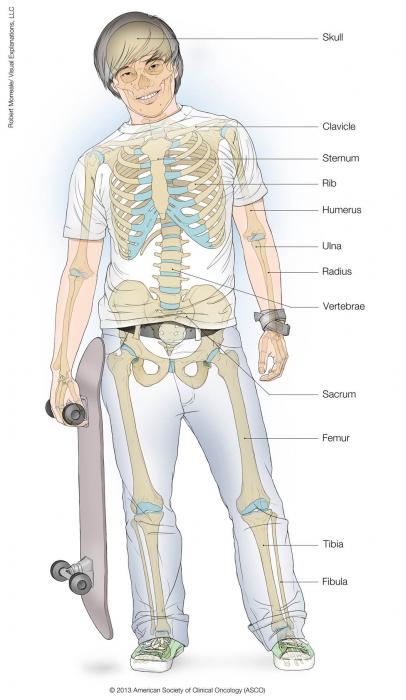ON THIS PAGE: You will find some basic information about Ewing sarcoma and the parts of the body it may affect. This is the first page of Cancer.Net’s Guide to Ewing Sarcoma - Childhood and Adolescence. Use the menu to see other pages. Think of that menu as a roadmap for this entire guide.
Ewing sarcoma is part of a group of cancers that affect the bones or nearby soft tissue. Cancer occurs when healthy cells change and grow out of control, forming a mass called a tumor. A tumor can be cancerous or benign. A cancerous tumor is malignant, meaning it can grow and spread to other parts of the body. A benign tumor means the tumor can grow but will not spread.
Where Ewing sarcoma develops
The illustration shows the major bones in the skeleton of a young adult. Bones highlighted include the skull and bones in the torso, such as the clavicle, ribs, sternum, vertebrae, and sacrum. The illustration also highlights the bones of the arms, including the humerus, ulna, and radius, and the bones of the legs, including the femur, tibia, and fibula.
Depending on the type, Ewing sarcomas develop in different places.
-
Bone. Ewing sarcoma most often develops in the leg, pelvis, ribs, arm, or spine.
-
Soft tissue. Previously included in the term “Ewing sarcoma family of tumors,” Ewing sarcoma is a tumor that can grow in the soft tissue outside of the bone. It is usually found in the thigh, pelvis, spine, chest wall, or foot.
Older terms, such as peripheral primitive neuroectodermal tumor, Askin tumor (Ewing sarcoma of the chest wall), and extraosseous Ewing sarcoma (often combined with the term "Ewing sarcoma family of tumors"), refer to this same type of tumor.
This section covers Ewing sarcoma diagnosed in children and young adults. For more information about Ewing sarcoma in adults, please read Cancer.Net's Guide to Bone Cancer.
Looking for More of an Introduction?
If you would like more of an introduction, explore these related items. Please note that these links will take you to other sections on Cancer.Net:
-
Cancer.Net Patient Education Videos: View a short video led by an American Society of Clinical Oncology (ASCO) expert that provides basic information about cancer in adolescents and young adults.
-
Cancer.Net En Español: Read about Ewing sarcoma in Spanish. Infórmase sobre sarcoma de Ewing en la niñez y adolescencia en español.
-
Find a Cancer Doctor. Search for a cancer specialist in your local area using this free database of doctors from ASCO.
-
Cancer Terms. Learn what medical phrases and terms used in cancer care and treatment mean.
The next section in this guide is Statistics. It helps explain how many children and young adults are diagnosed with Ewing sarcoma, as well as general survival rates. Use the menu to choose a different section to read in this guide.
